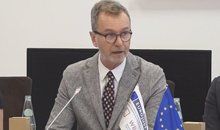
 Flash News
Flash News
The recount of votes for the Tirana district begins today
Albania among the 11 oldest countries in Europe, we aged 4 times more than the EU
Albania faces the risk of war, expert Softa in Politiko: Iran-Israel, an escalation that could also affect security in the Balkans
Horror scenes in the Tirana Morgue, decomposed bodies with worms! 18 bodies 'folded' into two 4-seat refrigerators
Korça/ A woman comes into contact with electricity
EC report: Albania's economy expected to slow down in 2025-2026

The European Commission expects the Albanian economy to slow in 2025-2026, to 3.5-3.6%, after strong growth of 4% in 2024.
The Commission bases the forecast on factors such as the slowing impact of wage increases in the public sector, slower growth in tourism, and the bottleneck caused in the labor market as a result of emigration, which is increasingly reducing the skilled labor force.
“After a strong growth momentum in previous years, Albania’s economy is expected to grow by 3.6% in 2025 and 3.5% in 2026, led by domestic demand. Supported by tourism, services exports are expected to continue to expand, while goods exports are expected to recover somewhat after two years of significant contraction. After a rapid decline in 2024, inflation is expected to gradually return to the 3% target next year. The fiscal deficit is expected to widen before falling below 2% of GDP in 2026. The public debt-to-GDP ratio is projected to decline only gradually, driven by nominal GDP growth,” the report says.
The EC emphasizes that Albania's economic growth remained strong in 2024, at 4%, led by strong domestic demand, good tourism performance and stable construction activity.
Household consumption growth was supported by real wage growth amid slowing inflation, as well as by accelerating credit growth. Public consumption growth was strong due to the second phase of the public sector wage reform. Job creation in the services sector supported employment growth. Services exports expanded, but goods exports declined significantly due to an unfavorable external environment and the strengthening of the lek.
Similar to 2023, most economic sectors recorded production growth, but agriculture and industry contracted.
In the period 2025–2026, GDP growth is projected to moderate compared to previous years, but remain stable at 3.6% and 3.5% respectively.
Public consumption growth is expected to slow as the impact of the wage reform fades, while private consumption, supported by real wage growth and improvements in the labor market, is expected to remain strong throughout the forecast horizon. Investment growth is supported by favorable financing conditions and the implementation of the Reform Agenda under the EU Reform and Growth Mechanism.
On the external front, services exports are expected to continue to expand, but growth in tourist arrivals is expected to moderate from the double-digit levels of recent years. After a sharp decline in 2024, goods exports are projected to recover somewhat, as the goods sector undergoes structural changes and the effect of currency appreciation fades.
The current account deficit is expected to increase slightly from the historically low level recorded in 2023, but remain significantly below the long-term average, indicating structural improvements brought about by the growth of tourism.
The EC predicts that risks remain on the downside, related to changes in exchange rates and interest rates, as well as the increasingly severe shortage of qualified labor, exacerbated by emigration.
As a small and open economy, Albania is exposed to external risks related to the economic impact of tariffs on its main EU trading partners, such as Italy. Furthermore, global uncertainties and geopolitical risks may affect the inflow of foreign direct investment.
Employment increased in 2024 and is expected to continue to grow in 2025–2026, albeit at a more moderate pace. A higher labor force participation rate is expected to be the main driver of labor supply growth, while continued emigration is likely to be a constraint. The unemployment rate is expected to remain stable, while wages continue to rise.
In 2024, the general government budget deficit narrowed to 0.7% of GDP, lower than the budget target of 2.3%. While revenues performed well, this fiscal outcome was partly the result of underperformance in public investment. The budget deficit is projected to widen to 2.4% of GDP in 2025, due to increased spending, especially capital spending.
Revenue growth is expected to be supported by the implementation of the medium-term revenue strategy during the period 2025–2026, which focuses on improving tax and customs administration.
A lower expenditure-to-GDP ratio (driven by cuts in both current and capital spending) is expected to help reduce the budget deficit to 1.9% of GDP in 2026.
The primary balance is projected to remain in surplus, in line with the national fiscal rule. The government debt-to-GDP ratio fell below 55% in 2024, supported by a positive primary balance, nominal GDP growth and the appreciation of the exchange rate. The debt ratio is expected to decline further in 2025–2026, but at a more moderate pace, driven by nominal GDP growth, the EC emphasizes./ Monitor
Latest news



Horoscope, what do the stars have in store for you today?
2025-06-18 08:12:05

Morning Post/ In 2 lines: What mattered yesterday in Albania
2025-06-18 07:45:20


Former prosecutor: Criminal groups are more structured in Albania
2025-06-17 22:02:21



Korça/ A woman comes into contact with electricity
2025-06-17 20:55:40

Death makes you neither good nor bad.
2025-06-17 20:38:05
Only 1 in 5 tourists sleep in apartments or hotels
2025-06-17 20:25:16

European Commission proposes complete ban on Russian gas imports
2025-06-17 19:46:58
'Serious concern': EU condemns government attacks on SPAK after Veliaj's arrest
2025-06-17 19:36:01
Fuel prices soar amid Israel-Iran tensions
2025-06-17 19:19:12



Iranian military says it struck Israeli military intelligence center in Tel Aviv
2025-06-17 18:17:27
The recount of 94 boxes of Gramsh and Peqin is completed
2025-06-17 18:08:47
Source: The world order is destroyed, how is the world being run today
2025-06-17 17:50:28

Albania and Serbia begin evacuations from Israel, Kosovo no clarification
2025-06-17 17:20:50
Exports have no power to recover, businesses suspend investments
2025-06-17 17:10:36
Atlanta United close to deal with Albania international center back
2025-06-17 16:59:03
The Bridge over the Buna hostage to bureaucracies
2025-06-17 16:50:46
'The White Horse of Celibashi'
2025-06-17 16:40:25
SP MP leaves SPAK, shuts up about the media: I can't speak
2025-06-17 16:29:15
Why was Belgium chosen for the Special Court convicts to serve their sentences?
2025-06-17 16:21:46
'Bunker-busting' bombs and Iran's nuclear base on a mountain
2025-06-17 16:18:53
Mother and daughter rape 14-year-old girl in Tirana
2025-06-17 16:08:15
Extreme temperatures, here are the foods you should eat to cope with the heat
2025-06-17 16:00:17


Cannabis was found on him, 20-year-old arrested in Vlora
2025-06-17 15:24:17
A dead body is found on "Bulevardi i Ri" in Tirana
2025-06-17 15:21:09
Fire in Elbasan, OST buildings engulfed in flames
2025-06-17 15:05:29

Egnatia learns the opponent in the Champions League
2025-06-17 14:55:26
Murder of Pjerin Xhuvani in Elbasan, Arbër Paplekaj requests conditional release
2025-06-17 14:45:24
The best cities to live in the world, Vienna falls from the throne again
2025-06-17 14:36:54
Plarent Ndreca summoned to the GJKKO
2025-06-17 14:31:16
Requests conditional release, hearing for Ervin Salianji postponed
2025-06-17 14:17:35
5 Albanians evacuated from Israel, expected to return to Albania
2025-06-17 14:06:31




Israel-Iran War/ Analysis by "The New Times": Who can endure more pain?
2025-06-17 13:10:39
Special Court leaves Veliaj in prison, SPAK presents new evidence
2025-06-17 12:57:51

The conflict between Israel and Iran floods the Albanian media with fake news
2025-06-17 12:28:49




Part of a criminal group, 54-year-old (Name) arrested in Tirana
2025-06-17 11:17:42
The constitution of the Kosovo Assembly fails for the 33rd time
2025-06-17 11:05:16

EU Ambassador: Criminal networks are using corruption to gain power
2025-06-17 10:37:45

Salianji requests conditional release, hearing to be held today at Fier Court
2025-06-17 10:15:40
Albanian caught with firearm in suitcase, arrested in Rinas (NAME)
2025-06-17 10:05:06
Israel says it has eliminated Iran's Armed Forces Chief of Staff
2025-06-17 09:52:30
BIRN: Recount of May 11 ballot boxes will last until July
2025-06-17 09:32:15
Seeking freedom, the Supreme Court will review Veliaj's appeal on July 8
2025-06-17 09:22:43
Accident on the Delvina-Saranda axis, "Toyota" goes off the road, driver injured
2025-06-17 09:10:08


Israel fires rocket barrage towards Israel
2025-06-17 08:31:44

Horoscope, what do the stars have in store for you today?
2025-06-17 08:13:40
Rain returns, here's the weather forecast for this Tuesday
2025-06-17 07:59:33
Morning Post/ In 2 lines: What mattered yesterday in Albania
2025-06-17 07:46:33



Media: Iran tried to shoot down Trump's plane during the election campaign
2025-06-16 22:04:15
Netanyahu: Eliminating Khamenei would end the conflict with Iran
2025-06-16 21:47:13
Lala: If the Supreme Court acquits Veliaj, a precedent will be created
2025-06-16 21:34:12

Laura Fazliu wins bronze medal at the World Judo Championships
2025-06-16 21:13:32

Car falls off bridge on Saranda-Delvina road, driver injured
2025-06-16 20:58:56
Tourist from Slovakia drowns near the Rock of Kavaja
2025-06-16 20:33:42

Cases of residential burglaries increase significantly during the summer
2025-06-16 20:19:28
Can Trump convince Netanyahu to stop attacking Iran?
2025-06-16 20:17:52
UN financial crisis puts aid for refugees at risk
2025-06-16 19:59:17


Tirana/ 253 complaints for road violations in just one week
2025-06-16 19:24:59


More and more armed drones over the Balkans and no one is watching them
2025-06-16 18:41:28
